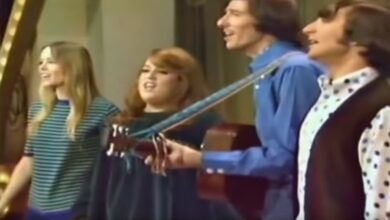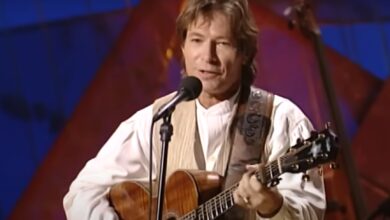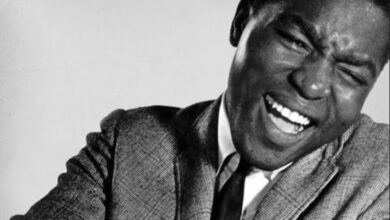The Turtles’ ‘Happy Together’ Redefines Pop Music in 1967
By the time Happy Together hit the airwaves in early 1967, The Turtles had already found moderate success with folk-rock tracks like It Ain’t Me Babe. However, it was this vibrant, harmony-driven anthem that catapulted them into the upper echelon of pop music. The song’s unforgettable melody, uplifting lyrics, and dynamic arrangement resonated with a generation caught in the cultural transformation of the late 1960s. It became the band’s signature hit, topping the Billboard Hot 100 and cementing its place as one of the most recognizable songs of the era.
The Turtles, originally formed as a surf rock band called The Crossfires in Los Angeles, transitioned into folk-rock in the wake of The Byrds’ success. Founding members Howard Kaylan and Mark Volman provided the group’s distinctive vocal harmonies, which would become their defining feature. Their early covers of Bob Dylan’s It Ain’t Me Babe and P.F. Sloan’s Let Me Be earned them critical recognition, but it wasn’t until they embraced a more polished pop sound that they achieved widespread acclaim.
Interestingly, Happy Together wasn’t initially written for The Turtles. The song was composed by Gary Bonner and Alan Gordon, a lesser-known songwriting duo who had struggled to find an artist willing to record their composition. The demo passed through multiple hands before The Turtles recognized its potential. Once the band got hold of it, they transformed it from a simple acoustic ballad into a full-fledged, orchestrated pop masterpiece.
The recording process took place in 1966 under the guidance of producer Joe Wissert. The arrangement was meticulously crafted, beginning with a simple guitar riff before blossoming into a full orchestral explosion by the chorus. Kaylan’s powerful lead vocals soared above the instrumental layers, while Volman’s harmonies provided a warm, rich texture. The track’s dynamic shifts—from subdued verses to an exuberant, almost symphonic chorus—were innovative for the time, making it stand out among the more straightforward pop recordings of the era.
Upon its release in February 1967, Happy Together quickly gained traction, eventually dethroning The Beatles’ Penny Lane from the No. 1 spot on the Billboard Hot 100. It remained at the top for three weeks, solidifying The Turtles as major players in the pop scene. The song also charted internationally, making waves in Canada, the UK, and Australia, further expanding the band’s reach.
The cultural impact of Happy Together was immediate. The song became an anthem of the era, associated with the optimistic, free-spirited vibe of the late ’60s. It provided a stark contrast to the growing social and political unrest of the time, offering a moment of joy and escapism in an increasingly turbulent world. The song’s universal theme of love and unity made it a staple at festivals, radio stations, and later, film soundtracks.
For The Turtles, Happy Together marked a turning point. It proved they could produce original material that rivaled the biggest acts of their time. The success of the song led to a string of hits, including She’d Rather Be With Me and Elenore, which carried the band further into pop stardom. However, the track’s massive success also overshadowed much of their subsequent work, making it both a blessing and a curse for the band.
Its influence extended beyond The Turtles themselves. Happy Together became a blueprint for harmony-driven pop, influencing bands like Three Dog Night and even early works of The Beach Boys in their post-Pet Sounds era. The song’s euphoric chorus and dynamic composition became a reference point for many future artists looking to capture a similar infectious energy in their music.
Over the years, Happy Together has been covered by a wide range of artists across genres. Rock band Filter delivered a darker, grittier rendition in the late ’90s, while Weezer paid homage to the song’s infectious spirit in their live performances. Other artists, including Hugo Montenegro, Captain & Tennille, and The Nylons, have all recorded their own versions, each bringing a unique twist to the classic.
Beyond music, the song has been featured in countless films, TV shows, and commercials. From romantic comedies to war movies, its uplifting nature has made it a go-to track for expressing happiness, nostalgia, and even irony. Films like Adaptation, The Simpsons Movie, and Minions have all utilized the song to enhance their storytelling, ensuring that new generations continue to discover and connect with it.
Despite their success, The Turtles faced industry challenges, including legal battles with their record label, which eventually led Kaylan and Volman to rebrand themselves as “Flo & Eddie” in the early 1970s. While they never replicated the astronomical success of Happy Together, they remained fixtures in the music world, collaborating with artists like Frank Zappa and continuing to perform the song that defined their career.
The song’s legacy endures, proving that a simple, well-crafted melody with an uplifting message can transcend time. Even in the 21st century, Happy Together continues to be used in pop culture, commercials, and sporting events, demonstrating its lasting appeal.
Reflecting on Happy Together, it’s clear that its magic lies in its ability to evoke joy with just a few notes. The opening guitar riff, the swell of harmonies, and the climactic chorus all work together to create an experience that feels timeless. Decades after its release, it remains a musical time capsule, capturing the essence of a moment when love, happiness, and optimism filled the airwaves.
For The Turtles, Happy Together was more than just a hit—it was their defining statement. Though their career took many turns after its release, the song remains their greatest contribution to pop music history. It stands as a reminder that sometimes, the simplest songs—those that make people smile, sing along, and feel good—are the ones that truly last forever.



